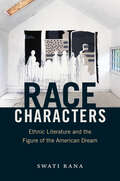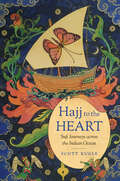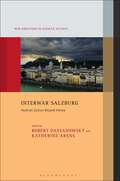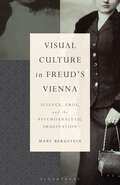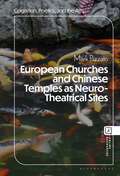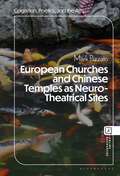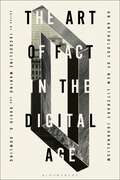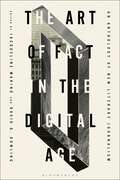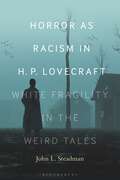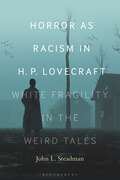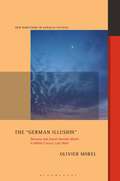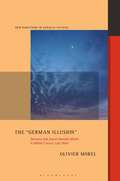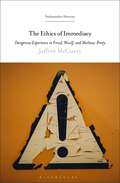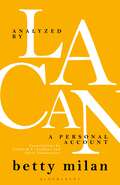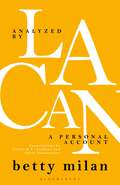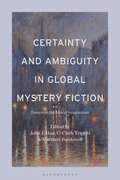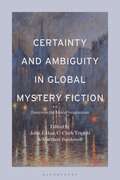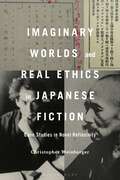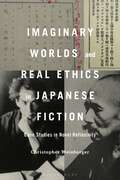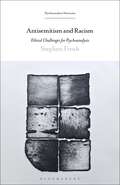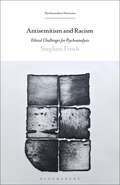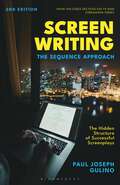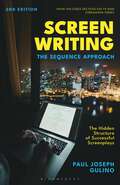- Table View
- List View
Race Characters: Ethnic Literature and the Figure of the American Dream
by Swati RanaA vexed figure inhabits U.S. literature and culture: the visibly racialized immigrant who disavows minority identity and embraces the American dream. Such figures are potent and controversial, for they promise to expiate racial violence and perpetuate an exceptionalist ideal of America. Swati Rana grapples with these figures, building on studies of literary character and racial form. Rana offers a new way to view characterization through racialization that creates a fuller social reading of race. Situated in a nascent period of ethnic identification from 1900 to 1960, this book focuses on immigrant writers who do not fit neatly into a resistance-based model of ethnic literature. Writings by Paule Marshall, Ameen Rihani, Dalip Singh Saund, Jose Garcia Villa, and Jose Antonio Villarreal symbolize different aspects of the American dream, from individualism to imperialism, assimilation to upward mobility. The dynamics of characterization are also those of contestation, Rana argues. Analyzing the interrelation of persona and personhood, Race Characters presents an original method of comparison, revealing how the protagonist of the American dream is socially constrained and structurally driven.
Hajj to the Heart: Sufi Journeys across the Indian Ocean (Islamic Civilization and Muslim Networks)
by Scott KugleAgainst the sweeping backdrop of South Asian history, this is a story of journeys taken by sixteenth-century reformist Muslim scholars and Sufi mystics from India to Arabia. At the center is the influential Sufi scholar Shaykh Ali Muttaqi and his little-known network of disciples. Scott Kugle relates how Ali Muttaqi, an expert in Arabic, scriptural hermeneutics, and hadith, left his native South Asia and traversed treacherous seas to make the Hajj to Mecca. Settling in Mecca, he continued to influence his homeland from overseas. Kugle draws on his original translations of Arabic and Persian manuscripts, never before available in English, to trace Ali Muttaqi's devotional writings, revealing how the Hajj transformed his spiritual life and political loyalties. The story expands across three generations of peripatetic Sufi masters in the Mutaqqi lineage as they travel for purposes of pilgrimage, scholarship, and sometimes simply for survival along Indian Ocean maritime routes linking global Muslim communities. Exploring the political intrigue, scholarly debates, and diverse social milieus that shaped the colorful personalities of his Sufi subjects, Kugle argues for the importance of Indian Sufi thought in the study of hadith and of ethics in Islam. We are proud to announce that this book is freely available in an open-access enhanced edition thanks to TOME (Toward an Open Monograph Ecosystem)—a collaboration of the Association of American Universities, the Association of University Presses, and the Association of Research Libraries—and the generous support of Emory University and the Andrew W. Mellon Foundation. Learn more at the TOME website: openmonographs.org. The open-access enhanced edition of Hajj to the Heart can be found here: https://manifold.ecds.emory.edu/projects/hajj-to-the-heart
Interwar Salzburg: Austrian Culture Beyond Vienna (New Directions in German Studies)
by Prof Imke MeyerA long-overdue reassessment of post-1918 Salzburg as a distinct Austrian cultural hub that experimented in moving beyond war and empire into a modern, self-consciously inclusive, and international center for European culture.For over 300 years, Salzburg had its own legacy as a city-state at an international crossroads, less stratified than Europe's colonial capitals and seeking a political identity based in civic participation with its own economy and politics. After World War I, Salzburg became a refuge. Its urban and bucolic spaces staged encounters that had been brutally cut apart by the war; its deep-seated traditions of citizenship, art, and education guided its path.In Interwar Salzburg, contributors from around the globe recover an evolving but now lost vanguard of European culture, fostering not only new identities in visual and performing arts, film, music, and literature, but also a festival culture aimed at cultivating an inclusive public (not an international elite) and a civic culture sharing public institutions, sports, tourism, and a diverse spectrum of cultural identities serving a new European ideal.
Interwar Salzburg: Austrian Culture Beyond Vienna (New Directions in German Studies)
by Prof Imke MeyerA long-overdue reassessment of post-1918 Salzburg as a distinct Austrian cultural hub that experimented in moving beyond war and empire into a modern, self-consciously inclusive, and international center for European culture.For over 300 years, Salzburg had its own legacy as a city-state at an international crossroads, less stratified than Europe's colonial capitals and seeking a political identity based in civic participation with its own economy and politics. After World War I, Salzburg became a refuge. Its urban and bucolic spaces staged encounters that had been brutally cut apart by the war; its deep-seated traditions of citizenship, art, and education guided its path.In Interwar Salzburg, contributors from around the globe recover an evolving but now lost vanguard of European culture, fostering not only new identities in visual and performing arts, film, music, and literature, but also a festival culture aimed at cultivating an inclusive public (not an international elite) and a civic culture sharing public institutions, sports, tourism, and a diverse spectrum of cultural identities serving a new European ideal.
Visual Culture in Freud's Vienna: Science, Eros, and the Psychoanalytic Imagination (Psychoanalytic Horizons)
by Professor Emerit Mary BergsteinVisual Culture in Freud's Vienna shows how photography and film in turn-of-the-century Vienna (the birthplace of psychoanalysis) not only reflected modernist ideas already in force, but helped to bring into being what might be referred to as a “psychoanalytic imagination.”Mary Bergstein demonstrates that visual images not only illustrated, but also engendered ways of seeing social, psychological, and scientific ideas during a formative time in the creation and development of psychoanalysis and the modern age. Indeed, she argues that visual culture initiated significant aspects of psychoanalytic thought.Visual Culture in Freud's Vienna examines a variety of visual materials and texts, ranging from scientific illustrations to popular "low culture" and even forms of erotica, including film. Attention is also given to women's dresses and shoes in a social context and as they are represented in photography and circulated as fetish objects.Bergstein maintains a commitment to women's history and feminist inquiry throughout, particularly in her final chapter, which is devoted to the representations of women in the erotic photography and film. Visual Culture in Freud's Vienna is well illustrated with images drawn from the sources discussed and makes a significant contribution to our understanding of modernism and psychoanalysis.
European Churches and Chinese Temples as Neuro-Theatrical Sites (Cognition, Poetics, and the Arts)
by Prof. or Dr. Mark PizzatoCompares monumental designs and performance spaces of Christian, Buddhist, and related sanctuaries, exploring how brain networks, animal-human emotions, and cultural ideals are reflected historically and affected today as "inner theatre" elements. Integrating research across the humanities and sciences, this book explores how traditional designs of outer theatrical spaces left cultural imprints for the inner staging of Self and Other consciousness, which each of us performs daily based on how we think others view us. But believers also perform in a cosmic theatre. Ancestral spirits and gods (or God) watch and interact with them in awe-inspiring spaces, grooming affects toward in-group identification and sacrifice, or out-group rivalry and scapegoating. In a study of over 80 buildings – shown by 40 images in the book, plus thousands of photos and videos online – Pizzato demonstrates how they reflect meta-theatrical projections from prior generations. They also affect the embodied, embedded, enacted, and extended (4E) cognition of current visitors, who bring performance frameworks of belief, hope, and doubt to the sacred site. This involves neuro-social, inner/outer theatre networks with patriarchal, maternal, and trickster paradigms. European Churches and Chinese Temples as Neuro-Theatrical Sites investigates performative material cultures, creating dialogs between theatre, philosophy, history, and various (cognitive, affective, social, biological) sciences. It applies them to the architecture of religious buildings: from Catholic, Orthodox, and Protestant in Europe, plus key sites in Jerusalem and prior “pagan” temples, to Buddhist, Daoist, Confucian, and imperial in China. It thus reveals individualist/collectivist, focal/holistic, analytical/dialectical, and melodramatic/tragicomic trajectories, with cathartic poetics for the future.
European Churches and Chinese Temples as Neuro-Theatrical Sites (Cognition, Poetics, and the Arts)
by Prof. or Dr. Mark PizzatoCompares monumental designs and performance spaces of Christian, Buddhist, and related sanctuaries, exploring how brain networks, animal-human emotions, and cultural ideals are reflected historically and affected today as "inner theatre" elements. Integrating research across the humanities and sciences, this book explores how traditional designs of outer theatrical spaces left cultural imprints for the inner staging of Self and Other consciousness, which each of us performs daily based on how we think others view us. But believers also perform in a cosmic theatre. Ancestral spirits and gods (or God) watch and interact with them in awe-inspiring spaces, grooming affects toward in-group identification and sacrifice, or out-group rivalry and scapegoating. In a study of over 80 buildings – shown by 40 images in the book, plus thousands of photos and videos online – Pizzato demonstrates how they reflect meta-theatrical projections from prior generations. They also affect the embodied, embedded, enacted, and extended (4E) cognition of current visitors, who bring performance frameworks of belief, hope, and doubt to the sacred site. This involves neuro-social, inner/outer theatre networks with patriarchal, maternal, and trickster paradigms. European Churches and Chinese Temples as Neuro-Theatrical Sites investigates performative material cultures, creating dialogs between theatre, philosophy, history, and various (cognitive, affective, social, biological) sciences. It applies them to the architecture of religious buildings: from Catholic, Orthodox, and Protestant in Europe, plus key sites in Jerusalem and prior “pagan” temples, to Buddhist, Daoist, Confucian, and imperial in China. It thus reveals individualist/collectivist, focal/holistic, analytical/dialectical, and melodramatic/tragicomic trajectories, with cathartic poetics for the future.
The Art of Fact in the Digital Age: An Anthology of New Literary Journalism
by Jacqueline Marino and David O. DowlingThe Art of Fact in the Digital Age is a showcase of the most powerful and moving journalism of the past 25 years. Selections include stories originally published in established bastions of literary journalism (The New York Times, The Atlantic and The New Yorker), as well as those from specialized and online publications (Runner's World, The Atavist). It features writers of extraordinary style (including Carina del Valle Schorske, Brian Phillips, and Jia Tolentino), as well as those who have profoundly influenced public discourse on the 21st century's most urgent issues: Mitchell S. Jackson, Clint Smith, and Ta-Nehisi Coates on race; Susan Dominus and Luke Mogelson on migration; and Kathryn Schulz and David Wallace-Wells on environmental threats. It even includes one story that expanded literary journalism's repertoire into audio (This American Life). This collection, assembled for students, scholars, and practitioners alike, also charts the evolution of digital longform journalism through its greatest achievements, from transitioning readers to screens to the integration of multimedia with words in service of meaning. The art of fact in the 21st century opened new ranges of expression to address such issues, while uniquely bearing the imprint of their generation's digital cultures and technologies. Although many forces compete for attention in the digital age, story triumphs. The works in this anthology show us why.
The Art of Fact in the Digital Age: An Anthology of New Literary Journalism
The Art of Fact in the Digital Age is a showcase of the most powerful and moving journalism of the past 25 years. Selections include stories originally published in established bastions of literary journalism (The New York Times, The Atlantic and The New Yorker), as well as those from specialized and online publications (Runner's World, The Atavist). It features writers of extraordinary style (including Carina del Valle Schorske, Brian Phillips, and Jia Tolentino), as well as those who have profoundly influenced public discourse on the 21st century's most urgent issues: Mitchell S. Jackson, Clint Smith, and Ta-Nehisi Coates on race; Susan Dominus and Luke Mogelson on migration; and Kathryn Schulz and David Wallace-Wells on environmental threats. It even includes one story that expanded literary journalism's repertoire into audio (This American Life). This collection, assembled for students, scholars, and practitioners alike, also charts the evolution of digital longform journalism through its greatest achievements, from transitioning readers to screens to the integration of multimedia with words in service of meaning. The art of fact in the 21st century opened new ranges of expression to address such issues, while uniquely bearing the imprint of their generation's digital cultures and technologies. Although many forces compete for attention in the digital age, story triumphs. The works in this anthology show us why.
Horror as Racism in H. P. Lovecraft: White Fragility in the Weird Tales
by Dr. or Prof. John L. SteadmanProviding a new perspective on Lovecraft's life and work, Horror as Racism in H.P. Lovecraft focuses on the overlap between the writer's personal beliefs and the racist images and narratives in his speculative fiction. Building on recent debates about Lovecraft and drawing on the concept of "white fragility," John Steadman argues that the writer's fiction reflects his feelings of resentment and anger towards non-white persons and was used to advocate for his racist, xenophobic political beliefs – that western civilization was in decline and slavery was justifiable among "superior" civilizations. In making these claims, Lovecraft's tales pit humans against extra-terrestrial aliens, developing a terrifying, futuristic vision of the Earth as a plantation planet. The familiar image of Lovecraft as a reclusive, creative genius and mentor to young writer-friends is dismantled through close readings of his fiction and nonfiction – including correspondence, essays, and poetry – and examination of his early biography. This image is replaced by that of a cruel, callous, and, at times, psychotic man, a violently vitriolic racist and white supremacist who hated most of the non-white races. While some will dismiss the author outright and others will read his fiction but ignore the racism, Horror as Racism in H.P. Lovecraft takes a middle ground: acknowledging Lovecraft's personal history and heinous intentions, it helps readers navigate the author's disturbing biography while also getting a better sense of the stories, which remain significant within American science fiction.
Horror as Racism in H. P. Lovecraft: White Fragility in the Weird Tales
by Dr. or Prof. John L. SteadmanProviding a new perspective on Lovecraft's life and work, Horror as Racism in H.P. Lovecraft focuses on the overlap between the writer's personal beliefs and the racist images and narratives in his speculative fiction. Building on recent debates about Lovecraft and drawing on the concept of "white fragility," John Steadman argues that the writer's fiction reflects his feelings of resentment and anger towards non-white persons and was used to advocate for his racist, xenophobic political beliefs – that western civilization was in decline and slavery was justifiable among "superior" civilizations. In making these claims, Lovecraft's tales pit humans against extra-terrestrial aliens, developing a terrifying, futuristic vision of the Earth as a plantation planet. The familiar image of Lovecraft as a reclusive, creative genius and mentor to young writer-friends is dismantled through close readings of his fiction and nonfiction – including correspondence, essays, and poetry – and examination of his early biography. This image is replaced by that of a cruel, callous, and, at times, psychotic man, a violently vitriolic racist and white supremacist who hated most of the non-white races. While some will dismiss the author outright and others will read his fiction but ignore the racism, Horror as Racism in H.P. Lovecraft takes a middle ground: acknowledging Lovecraft's personal history and heinous intentions, it helps readers navigate the author's disturbing biography while also getting a better sense of the stories, which remain significant within American science fiction.
The "German Illusion": Germany and Jewish-German Motifs in Hélène Cixous’s Late Work (New Directions in German Studies)
by Professor or Dr. Olivier MorelExamines Jewish-German “tropes” in Hélène Cixous's oeuvre and life and their impact on her work as a feminist, poet, and playwright.Hélène Cixous is a poet, philosopher, and activist known worldwide for her manifesto on Écriture feminine (feminine writing) and for her influential literary texts, plays, and essays. While the themes were rarely present in her earlier writings, Germany and Jewish-German family figures and topics have significantly informed most of Cixous's late works. Born in Algeria in June 1937, she grew up with a mother who had escaped Germany after the rise of Nazism and a grandmother who fled the racial laws of the Third Reich in 1938. In her writing, Cixous refines the primitive scene of a “German” upbringing in French-occupied colonial, antisemitic Algeria.Scholar and filmmaker Olivier Morel delves into the signs and influences that “Germany,” “German,” and “Osnabrück” have exerted over Cixous's work. Featuring an exclusive interview with Hélène Cixous and stills from their travel together to Osnabrück in Morel's 2018 documentary, Ever, Rêve, Hélène Cixous, Morel's The “German Illusion” examines the unique literary meditation on the Holocaust sustained throughout her later texts. Morel helps us to understand an uncannily original oeuvre that embodies the complexities of modernity's genocidal history in a new way.
The "German Illusion": Germany and Jewish-German Motifs in Hélène Cixous’s Late Work (New Directions in German Studies)
by Professor or Dr. Olivier MorelExamines Jewish-German “tropes” in Hélène Cixous's oeuvre and life and their impact on her work as a feminist, poet, and playwright.Hélène Cixous is a poet, philosopher, and activist known worldwide for her manifesto on Écriture feminine (feminine writing) and for her influential literary texts, plays, and essays. While the themes were rarely present in her earlier writings, Germany and Jewish-German family figures and topics have significantly informed most of Cixous's late works. Born in Algeria in June 1937, she grew up with a mother who had escaped Germany after the rise of Nazism and a grandmother who fled the racial laws of the Third Reich in 1938. In her writing, Cixous refines the primitive scene of a “German” upbringing in French-occupied colonial, antisemitic Algeria.Scholar and filmmaker Olivier Morel delves into the signs and influences that “Germany,” “German,” and “Osnabrück” have exerted over Cixous's work. Featuring an exclusive interview with Hélène Cixous and stills from their travel together to Osnabrück in Morel's 2018 documentary, Ever, Rêve, Hélène Cixous, Morel's The “German Illusion” examines the unique literary meditation on the Holocaust sustained throughout her later texts. Morel helps us to understand an uncannily original oeuvre that embodies the complexities of modernity's genocidal history in a new way.
The Ethics of Immediacy: Dangerous Experience in Freud, Woolf, and Merleau-Ponty (Psychoanalytic Horizons)
by Dr. Jeffrey McCurryDrawing connections between Freudian psychoanalysis, Virginia Woolf's criticism and fiction, and Maurice Merleau-Ponty's phenomenology, The Ethics of Immediacy recounts the far-reaching consequences of the modern turn towards a new ethics of immediacy. During the first half of the 20th century, a profound transformation – an existential revolution – took place in European culture in how human beings conceived of themselves. Inspired by Freud's psychoanalysis, a newfound appreciation for the realm of immediate experience in human life emerged. With Freud himself making a signal contribution to this existential revolution, and with Woolf and Merleau-Ponty taking up Freud's ideas in their own unique ways, all three figures began to regard first-order, spontaneous, direct, unselfconscious, concrete experience of self and world as standing at the heart of what it means to be human.Jeffrey McCurry describes how this new state of affairs stood in contrast to how immediate experience had been historically dismissed, devalued, repressed, and even negated in the fields of psychology, literature, and philosophy. This experience posed dangers to psychological stability, social order, and philosophical certainty. McCurry examines how Freud's psychoanalytic theory, Woolf's modernist criticism and fiction, and Merleau-Ponty's phenomenology, psychology, literature, and philosophy in turns embraced the risks and dangers of putting immediate experience as the center of humanity, of respecting, understanding, appreciating, and following the lead of immediate, spontaneous, pre-reflective, pre-evaluative, concrete experience in human life.
The Ethics of Immediacy: Dangerous Experience in Freud, Woolf, and Merleau-Ponty (Psychoanalytic Horizons)
by Dr. Jeffrey McCurryDrawing connections between Freudian psychoanalysis, Virginia Woolf's criticism and fiction, and Maurice Merleau-Ponty's phenomenology, The Ethics of Immediacy recounts the far-reaching consequences of the modern turn towards a new ethics of immediacy. During the first half of the 20th century, a profound transformation – an existential revolution – took place in European culture in how human beings conceived of themselves. Inspired by Freud's psychoanalysis, a newfound appreciation for the realm of immediate experience in human life emerged. With Freud himself making a signal contribution to this existential revolution, and with Woolf and Merleau-Ponty taking up Freud's ideas in their own unique ways, all three figures began to regard first-order, spontaneous, direct, unselfconscious, concrete experience of self and world as standing at the heart of what it means to be human.Jeffrey McCurry describes how this new state of affairs stood in contrast to how immediate experience had been historically dismissed, devalued, repressed, and even negated in the fields of psychology, literature, and philosophy. This experience posed dangers to psychological stability, social order, and philosophical certainty. McCurry examines how Freud's psychoanalytic theory, Woolf's modernist criticism and fiction, and Merleau-Ponty's phenomenology, psychology, literature, and philosophy in turns embraced the risks and dangers of putting immediate experience as the center of humanity, of respecting, understanding, appreciating, and following the lead of immediate, spontaneous, pre-reflective, pre-evaluative, concrete experience in human life.
Analyzed by Lacan: A Personal Account (Psychoanalytic Horizons)
by Dr. Betty MilanAnalyzed by Lacan brings together the first English translations of Why Lacan, Betty Milan's memoir of her analysis with Lacan in the 1970s, and her play, Goodbye Doctor, inspired by her experience. Why Lacan provides a unique and valuable perspective on how Lacan worked as psychoanalyst as well as his approach to psychoanalytic theory. Milan's testimony shows that Lacan's method of working was based on the idea that the traditional way of interpreting provoked resistance. Prior to Why Lacan, Milan wrote a play, Goodbye Doctor, based on her experience as Lacan's patient. The play is structured around the sessions of Seriema with the Doctor. Through the analysis, Seriema discovers why she cannot give birth, namely, an unconscious desire to satisfy the will of her father who didn't authorize her to conceive. She ceases to be the victim of her unconscious, grasps the possibility of choosing a father for her child and thus becoming a mother. Goodbye Doctor has been adapted into a film, Adieu Lacan, by the director Richard Ledes. Analyzed by Lacan features an Introduction by Milan to both works as well as a new interview with Mari Ruti about her writing and Lacan.
Analyzed by Lacan: A Personal Account (Psychoanalytic Horizons)
by Dr. Betty MilanAnalyzed by Lacan brings together the first English translations of Why Lacan, Betty Milan's memoir of her analysis with Lacan in the 1970s, and her play, Goodbye Doctor, inspired by her experience. Why Lacan provides a unique and valuable perspective on how Lacan worked as psychoanalyst as well as his approach to psychoanalytic theory. Milan's testimony shows that Lacan's method of working was based on the idea that the traditional way of interpreting provoked resistance. Prior to Why Lacan, Milan wrote a play, Goodbye Doctor, based on her experience as Lacan's patient. The play is structured around the sessions of Seriema with the Doctor. Through the analysis, Seriema discovers why she cannot give birth, namely, an unconscious desire to satisfy the will of her father who didn't authorize her to conceive. She ceases to be the victim of her unconscious, grasps the possibility of choosing a father for her child and thus becoming a mother. Goodbye Doctor has been adapted into a film, Adieu Lacan, by the director Richard Ledes. Analyzed by Lacan features an Introduction by Milan to both works as well as a new interview with Mari Ruti about her writing and Lacan.
Certainty and Ambiguity in Global Mystery Fiction: Essays on the Moral Imagination
Mystery fiction as a genre renders moral judgments not only about detectives and criminals but also concerning the cultural structures within which these mysteries unfold.In contrast to other volumes which examine morality in crime fiction through the lenses of personal guilt and personal justice, Certainty and Ambiguity in Global Mystery Fiction analyzes the effect of moral imagination on the moral structures implicit in the genre. In recent years, public awareness has attended to the relationship between social structures and justice, and this collection centers on how personal ethics and social ethics are bound together amidst the shifting moral landscapes of mystery fiction.Contributors discuss the interplay between personal guilt and social guilt – considering morality and justice on an individual level and at a societal level – using frameworks of certainty and ambiguity. They show how individual characters in works by Agatha Christie, Gabriel García Márquez, Natsuo Kirino, F.H. Batacan, and Stephen King, among others, may view their moral standing with certainty but clash with the established mores of their culture. Featuring essays on Japanese, Filipino, Indian, and Colombian mystery fiction, as well as American and British fiction, this volume analyzes social guilt and justice across cultures, showing how individuals grapple with the certainty, and, at times, the moral ambiguity, of their respective cultures.
Certainty and Ambiguity in Global Mystery Fiction: Essays on the Moral Imagination
by John J. Han, C. Clark Triplett, and Matthew BardowellMystery fiction as a genre renders moral judgments not only about detectives and criminals but also concerning the cultural structures within which these mysteries unfold.In contrast to other volumes which examine morality in crime fiction through the lenses of personal guilt and personal justice, Certainty and Ambiguity in Global Mystery Fiction analyzes the effect of moral imagination on the moral structures implicit in the genre. In recent years, public awareness has attended to the relationship between social structures and justice, and this collection centers on how personal ethics and social ethics are bound together amidst the shifting moral landscapes of mystery fiction.Contributors discuss the interplay between personal guilt and social guilt – considering morality and justice on an individual level and at a societal level – using frameworks of certainty and ambiguity. They show how individual characters in works by Agatha Christie, Gabriel García Márquez, Natsuo Kirino, F.H. Batacan, and Stephen King, among others, may view their moral standing with certainty but clash with the established mores of their culture. Featuring essays on Japanese, Filipino, Indian, and Colombian mystery fiction, as well as American and British fiction, this volume analyzes social guilt and justice across cultures, showing how individuals grapple with the certainty, and, at times, the moral ambiguity, of their respective cultures.
Imaginary Worlds and Real Ethics in Japanese Fiction: Case Studies in Novel Reflexivity
by Professor or Dr. Christopher WeinbergerCan novels contribute to the ethical lives of readers? What responsibilities might they bear in representing others? Are we ethically accountable for how we read fiction? This study takes up modern Japanese fiction and metafiction, subjects overwhelmingly ignored by Anglophone scholarship on novel ethics, to discover pioneering answers to these and other questions. Each chapter offers new readings of major works of modern Japanese literature (1880s through 1920s) that experiment with the capacity of novel narration to involve readers in ethically freighted encounters. Christopher Weinberger shows that Mori Ogai and Akutagawa Ryunosuke help to address key issues in new ethical theories today: debates about the roles that identification and empathy play in novel ethics; concerns about the representation of “otherness” and alterity in novels; divergence between cognitive and affective theories of ethics; widespread disagreement about what novel ethics obtain in the experience of reading, the effects of reading, or the form or content of novel representation; and, finally, concerns with bias and appropriation in the study of world literature. Concluding with a jump to the present, Imaginary Worlds and Real Ethics in Japanese Fiction puts on display a startling continuity between the methods of Japan's modern novel progenitors and those of novelists at the forefront of global literature today, especially Haruki Murakami. Ultimately, this book models an original approach to ethical criticism while demonstrating the relevance of modern Japanese fiction for rethinking contemporary theories of the novel.
Imaginary Worlds and Real Ethics in Japanese Fiction: Case Studies in Novel Reflexivity
by Professor or Dr. Christopher WeinbergerCan novels contribute to the ethical lives of readers? What responsibilities might they bear in representing others? Are we ethically accountable for how we read fiction? This study takes up modern Japanese fiction and metafiction, subjects overwhelmingly ignored by Anglophone scholarship on novel ethics, to discover pioneering answers to these and other questions. Each chapter offers new readings of major works of modern Japanese literature (1880s through 1920s) that experiment with the capacity of novel narration to involve readers in ethically freighted encounters. Christopher Weinberger shows that Mori Ogai and Akutagawa Ryunosuke help to address key issues in new ethical theories today: debates about the roles that identification and empathy play in novel ethics; concerns about the representation of “otherness” and alterity in novels; divergence between cognitive and affective theories of ethics; widespread disagreement about what novel ethics obtain in the experience of reading, the effects of reading, or the form or content of novel representation; and, finally, concerns with bias and appropriation in the study of world literature. Concluding with a jump to the present, Imaginary Worlds and Real Ethics in Japanese Fiction puts on display a startling continuity between the methods of Japan's modern novel progenitors and those of novelists at the forefront of global literature today, especially Haruki Murakami. Ultimately, this book models an original approach to ethical criticism while demonstrating the relevance of modern Japanese fiction for rethinking contemporary theories of the novel.
Antisemitism and Racism: Ethical Challenges for Psychoanalysis (Psychoanalytic Horizons)
by Stephen FroshPsychoanalysis has not had a comfortable history in relation to "race" and racism, despite its origins in the Jewish lives of Freud and its other first-generation progenitors and the insistent pressure of antisemitism upon it. Indeed, the failure to fully address racism is a running sore in the psychoanalytic movement. This has begun to be remedied in recent years, but it is still the case that psychoanalysis struggles to incorporate antiracist perspectives and that this might be a reason why it has engaged relatively poorly with Black communities. Psychoanalysis may have been a "Jewish science" in a positive sense, but it has not fully leveraged this to become a truly antiracist one.In Antisemitism and Racism, Stephen Frosh, a leading figure in psychoanalytic studies, provides a psychoanalytically-informed examination of the relations between antisemitism and antiblack racism. Frosh's starting point is a claim that the Jewish origins and implications of psychoanalysis fuel its capacity to interrogate racism of all kinds. Indeed, the shared experience of exposure to different kinds of racism raises prospects for renewed alliances between Jewish and Black communities. Antisemitism and Racism ends with a chapter that asks psychoanalysis itself to respond to some of the challenges emerging from the Black Lives Matter and decolonial movements.At a time when division and prejudice are on the rise to an alarming degree, it is imperative that we examine, understand, and discuss the psychological roots of racism.
Antisemitism and Racism: Ethical Challenges for Psychoanalysis (Psychoanalytic Horizons)
by Stephen FroshPsychoanalysis has not had a comfortable history in relation to "race" and racism, despite its origins in the Jewish lives of Freud and its other first-generation progenitors and the insistent pressure of antisemitism upon it. Indeed, the failure to fully address racism is a running sore in the psychoanalytic movement. This has begun to be remedied in recent years, but it is still the case that psychoanalysis struggles to incorporate antiracist perspectives and that this might be a reason why it has engaged relatively poorly with Black communities. Psychoanalysis may have been a "Jewish science" in a positive sense, but it has not fully leveraged this to become a truly antiracist one.In Antisemitism and Racism, Stephen Frosh, a leading figure in psychoanalytic studies, provides a psychoanalytically-informed examination of the relations between antisemitism and antiblack racism. Frosh's starting point is a claim that the Jewish origins and implications of psychoanalysis fuel its capacity to interrogate racism of all kinds. Indeed, the shared experience of exposure to different kinds of racism raises prospects for renewed alliances between Jewish and Black communities. Antisemitism and Racism ends with a chapter that asks psychoanalysis itself to respond to some of the challenges emerging from the Black Lives Matter and decolonial movements.At a time when division and prejudice are on the rise to an alarming degree, it is imperative that we examine, understand, and discuss the psychological roots of racism.
Screenwriting: The Sequence Approach
by Professor Paul Joseph GulinoA substantial update of the previous edition, Screenwriting: The Sequence Approach deconstructs recent feature films and offers a new section analysing popular television series.A proven screenwriting method in emotionally engaging an audience, the sequence approach emphasises the underlying motives of each story plot to better convey its relation to the work as a whole. In this expanded second edition, Paul Gulino includes analyses of recent noteworthy films and serial dramas, such as Parasite, Barry and Breaking Bad, with an eye to how they manage audience attention, convey vital information and deliver their emotional payloads. The aim of the book is to help writers move readily from the feature film to the serial form, mastering both. It is perfect for both beginning writers and those with experience in the feature screenplay form.
Screenwriting: The Sequence Approach
by Professor Paul Joseph GulinoA substantial update of the previous edition, Screenwriting: The Sequence Approach deconstructs recent feature films and offers a new section analysing popular television series.A proven screenwriting method in emotionally engaging an audience, the sequence approach emphasises the underlying motives of each story plot to better convey its relation to the work as a whole. In this expanded second edition, Paul Gulino includes analyses of recent noteworthy films and serial dramas, such as Parasite, Barry and Breaking Bad, with an eye to how they manage audience attention, convey vital information and deliver their emotional payloads. The aim of the book is to help writers move readily from the feature film to the serial form, mastering both. It is perfect for both beginning writers and those with experience in the feature screenplay form.
